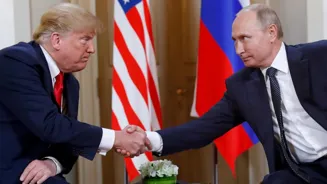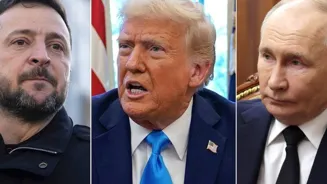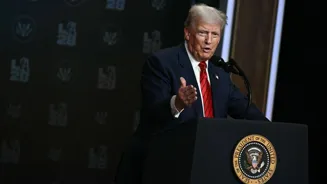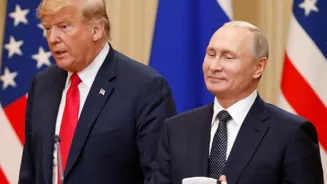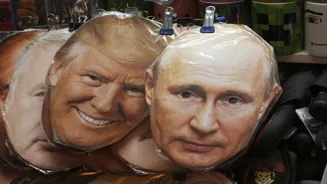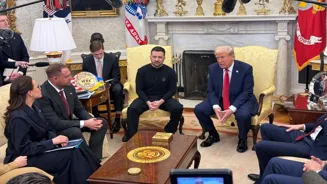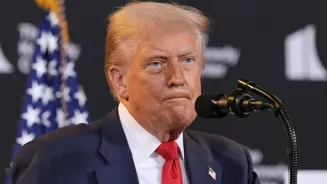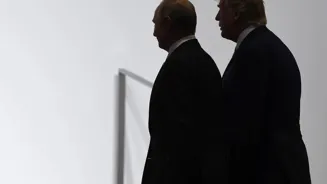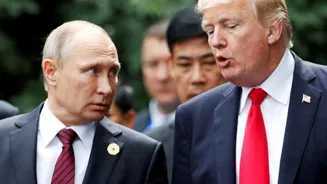When US President Donald Trump and Russian President Vladimir Putin meet in Alaska on Friday, it will be their first face-to-face encounter since Trump’s return to the White House and their first meeting
in more than seven years. It also marks one of the most significant moments in US–Russia relations since the war in Ukraine began in 2022.
The summit was finalised in barely a week, a sharp departure from Washington’s policy of isolating Putin after the invasion that has killed hundreds of thousands and devastated both countries. For the Kremlin, the very fact of the meeting is already a diplomatic win; for Trump, it is an opportunity to see if his self-proclaimed deal-making skills can yield even the beginnings of a ceasefire.
The talks will take place at Joint Base Elmendorf-Richardson in Anchorage. According to the Kremlin, the leaders will begin with a one-on-one discussion with interpreters, followed by delegation-level talks over a working breakfast, and conclude with a joint press conference. White House press secretary Karoline Leavitt has described the encounter as a “listening exercise” for Trump.
Possible Outcomes From The Alaska Talks
With both leaders arriving in Anchorage with sharply different aims, expectations are low, but the outcomes could still be significant. The talks might produce symbolic measures, such as a commitment to continue negotiations, the announcement of a follow-up meeting involving Ukraine, or limited humanitarian steps like prisoner exchanges and pledges to protect civilian infrastructure.
Another scenario is a loosely worded framework for a potential ceasefire, possibly involving a monitored pause in hostilities. However, anything seen as legitimising Russia’s territorial gains would draw strong opposition from Kyiv and European capitals.
It is also possible the meeting ends without substantive agreements, with Putin gaining the optics of being treated as a global player and Trump portraying the summit as a valuable “testing of the waters” while keeping the door open for future talks.
Why Is The Alaska Summit Happening Now?
According to The New York Times, both sides had discussed a possible summit since January but saw no clear path forward. Putin, confident of Russia’s battlefield position, felt no urgency to negotiate. Trump, initially supportive of Moscow’s position and critical of US military aid to Kyiv, also held off while a resolution seemed unlikely.
That changed last week when Trump advanced a deadline for imposing new sanctions and tariffs unless Russia took steps toward ending the war. He also raised tariffs on Indian imports to 50 per cent to penalise New Delhi for continuing to buy Russian oil. Days later, the Kremlin requested the meeting.
The timing also reflects political calculations. For Putin, it is a chance to reassert Russia on the world stage. For Trump, it is an opportunity to show progress toward his campaign pledge to end the war, and, as he has often hinted, to bolster his case for a Nobel Peace Prize.
What Does Putin Want From The Summit?
Putin’s first gain is recognition. By meeting the US president on American soil and holding a joint press conference, the Kremlin can claim that Western isolation has failed. “So much for being isolated,” crowed the Russian tabloid Moskovsky Komsomolets earlier this week.
Alaska offers both practical and symbolic advantages. At its closest point, mainland Alaska is only 90km across the Bering Strait from Russia’s Chukotka Autonomous Okrug, a remote, sparsely populated region in the Far East that Putin has visited multiple times to underline its strategic value. This proximity allows him to travel to the summit without overflying “hostile” nations — Kremlin shorthand for countries that have closed their airspace to Russian aircraft since 2022, including most of Europe, Canada, and the US itself outside of special arrangements.
The location also keeps the meeting far from Ukraine and the European Union, consistent with Moscow’s strategy of sidelining Kyiv and EU leaders in favour of direct talks with Washington. It carries historical symbolism too: Russia sold Alaska to the US in 1867, and Russian state media cite the sale as proof that borders can change, a narrative the Kremlin uses to justify its actions in Ukraine.
On substance, Putin’s demands remain maximalist. As per NYT, he wants Russia to keep all territory seized in Donetsk, Luhansk, Zaporizhzhia and Kherson, bar Ukraine from NATO membership, limit its armed forces, and ensure a pro-Moscow government in Kyiv. Ukraine has rejected these outright, with President Volodymyr Zelenskyy declaring, “Ukrainians will not give their land to the occupier.”
Putin may also broaden the agenda to include economic cooperation, the Arctic, and other US–Russia issues, or simply use the meeting to buy time while consolidating battlefield gains.
What Does Trump Hope To Achieve?
Trump entered office promising to end the Ukraine war in 24 hours. More than six months into his presidency, that goal remains unfulfilled, but it continues to shape his approach.
His stance toward Russia has swung between conciliation and confrontation. Early this year, he suspended military aid to Ukraine and publicly berated Zelenskyy in a dramatic Oval Office meeting. More recently, he has condemned Russia’s attacks on civilians as “disgraceful” and “disgusting”, and warned of “very severe consequences” if Putin refuses to halt the war.
This week, Trump called the Alaska meeting a “feel-out” session, saying he might know within “the first two minutes” if a deal is possible. While lowering expectations by describing it as a listening exercise, he also suggested that both Putin and Zelenskyy want peace. Even modest progress, such as agreeing to further talks or limited humanitarian steps, could be cast as a political win and evidence of his peacemaker credentials.
Why Ukraine And Europe Are Wary
Kyiv’s absence from the Anchorage talks is a major concern for Ukraine and its allies. On Wednesday, Zelenskyy joined a call with Trump and European leaders to outline five principles for negotiations, according to NYT. Chief among them was that a ceasefire must come first.
European governments fear bilateral US–Russia talks could lead to proposals, such as a “land swap”, that Ukraine cannot accept. They also worry that if Kyiv rejects such terms, Trump could scale back US support. For Ukraine, any deal that legitimises Russian territorial gains is unacceptable.
Trump–Putin Relationship
The Trump–Putin relationship has been closely watched since their first meeting at the 2017 G20 summit in Hamburg, where they exchanged warm words and a businesslike handshake. Ukraine was on the agenda even then, with Trump raising concerns about Russia’s destabilisation efforts, a reference to Moscow’s 2014 annexation of Crimea and its backing of separatists in eastern Ukraine’s Donetsk and Luhansk regions, which kept the conflict simmering well before the 2022 full-scale invasion.
They have met at multiple forums since. The 2018 Helsinki summit was especially controversial, with Trump siding with Putin over US intelligence agencies on Russian election interference, a stance that drew bipartisan criticism at home.
Former officials told the BBC that Putin tends to dominate conversations with long, rapid monologues, controlling the agenda and leaving little space for responses. Fiona Hill, a former Trump adviser, has said Putin sometimes uses sarcasm in Russian that is “totally lost in translation” and has mocked Trump.
John Bolton, Trump’s former national security adviser, described Putin as methodical and always prepared, traits he attributes to the Russian leader’s KGB training, while Trump prefers an unstructured, freewheeling style. This, Bolton argues, can give Putin an advantage in one-on-one talks.
The Bottom Line
The Trump–Putin Alaska summit is as much about optics and positioning as it is about the war in Ukraine. For Putin, it is a platform to show that Russia is not isolated and to press his demands directly to Washington. For Trump, it is a chance to project statesmanship and lay even a thin foundation for a legacy as a peacemaker.
Without Ukraine at the table, any agreement will be hard to implement. But in a war now in its fourth year, even symbolic gestures toward dialogue will be scrutinised, and heavily spun, by both sides.
